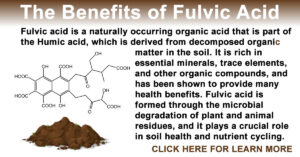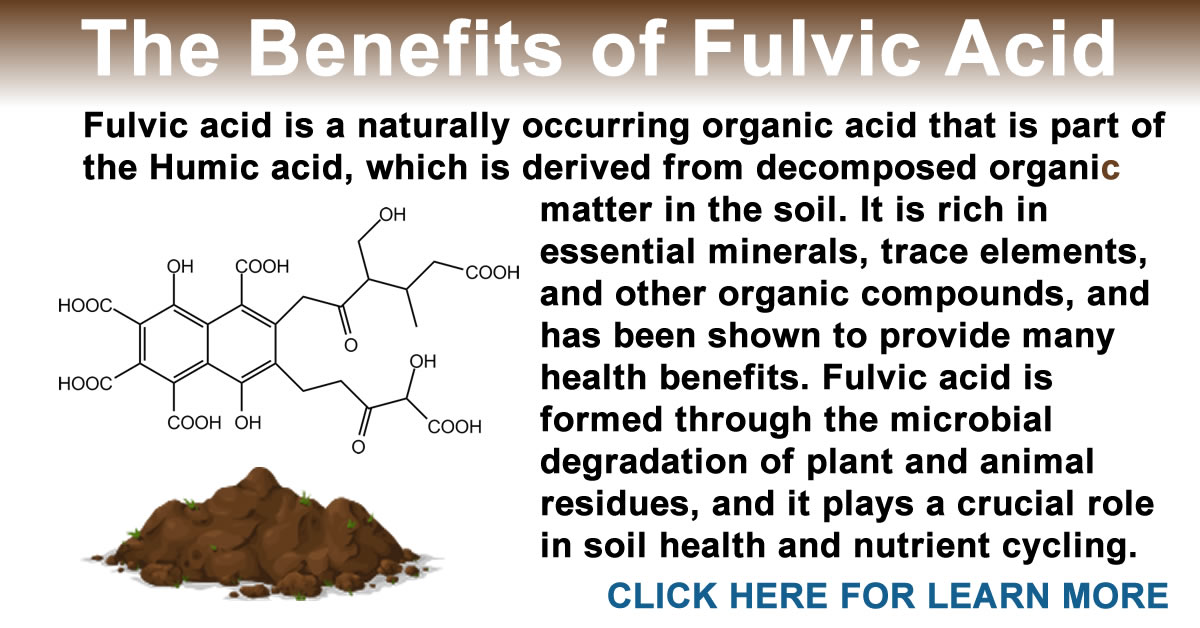Fulvic Acid and its Benefits
 Fulvic acid is composed of various organic molecules, including fulvic acids, humic acids, and humins. It is a complex mixture containing carbon, hydrogen, oxygen, nitrogen, sulfur, and other trace elements. Their small size allows them to be more soluble in water and easily absorbed by plant roots and other organisms. It is also soluble in both acidic and alkaline conditions. Here are the benefits that Fulvic acid has been shown to provide in studies;
Fulvic acid is composed of various organic molecules, including fulvic acids, humic acids, and humins. It is a complex mixture containing carbon, hydrogen, oxygen, nitrogen, sulfur, and other trace elements. Their small size allows them to be more soluble in water and easily absorbed by plant roots and other organisms. It is also soluble in both acidic and alkaline conditions. Here are the benefits that Fulvic acid has been shown to provide in studies;
- Chelation: Fulvic acid is believed to chelate minerals and make them more easily absorbable by the body. This chelation process may enhance the bioavailability of essential minerals like zinc, iron, and magnesium[i].
- Free Radical Scavenging: Fulvic acid has been suggested to act as an antioxidant, helping to neutralize free radicals in the body. Free radicals are unstable molecules that can cause oxidative stress, which is associated with various health issues, including aging and chronic diseases[ii]–[iii].
- Mitochondrial Function: Some studies propose that fulvic acid may support mitochondrial function. Mitochondria are the energy-producing structures within cells, and optimizing their function is crucial for overall cellular health[iv].
- Digestive Support: Fulvic acid may play a role in maintaining a healthy balance of gut microbiota. A balanced gut microbiome is associated with improved digestion, nutrient absorption, and overall well-being[v]–[vi].
- Anti-inflammatory Properties: Some research suggests that fulvic acid may exhibit anti-inflammatory effects, potentially contributing to the reduction of inflammation in the body, including Joint Health [vii]
- Enhanced Immune Response: Fulvic acid has been explored for its immunomodulatory effects, potentially supporting the immune system by regulating immune responses[viii].
- Topical Skin Application: Fulvic acid is sometimes used in skincare products for its purported benefits, including potential anti-aging effects and skin hydration[ix].
- Cognitive Function & Neuroprotective Effects: Preliminary studies suggest that fulvic acid might have neuroprotective properties, potentially contributing to cognitive health[x]–[xi].
Toxicity, in the human clinical toxicity assessment study, FA is indicated to be safe in humans at a daily dosage of 1.8 grams[xii]
It’s important to note that while there is some scientific research supporting these potential benefits, the field is still emerging, and more research is needed to fully understand the mechanisms and long-term effects of fulvic acid supplementation.
Citations
[i] Meena H, Pandey HK, Arya MC, Ahmed Z. Shilajit: A panacea for high-altitude problems. Int J Ayurveda Res. 2010 Jan;1(1):37-40. doi: 10.4103/0974-7788.59942. PMID: 20532096; PMCID: PMC2876922.
[ii] Swat M, Rybicka I, Gliszczyńska-Świgło A. Characterization of Fulvic Acid Beverages by Mineral Profile and Antioxidant Capacity. Foods. 2019 Nov 22;8(12):605. doi: 10.3390/foods8120605. PMID: 31766604; PMCID: PMC6963745.
[iii] Shikalgar T. S., Naikwade N. S. Evaluation of cardioprotective activity of fulvic acid against isoproterenol induced oxidative damage in rat myocardium. International Research Journal of Pharmacy. 2018;9(1):71–80. doi: 10.7897/2230-8407.09111.
[iv] Visser SA. Effect of humic substances on mitochondrial respiration and oxidative phosphorylation. Sci Total Environ. 1987 Apr;62:347-54. doi: 10.1016/0048-9697(87)90521-3. PMID: 2953069.
[v] Kim L. S., Hilli L., Orlowski J., Kupperman J. L., Baral M., Waters R. F. Efficacy of probiotics and nutrients in functional gastrointestinal disorders: a preliminary clinical trial. Digestive Diseases and Sciences. 2006;51(12):2134–2144. doi: 10.1007/s10620-006-9297-8.
[vi] Winkler J, Ghosh S. Therapeutic Potential of Fulvic Acid in Chronic Inflammatory Diseases and Diabetes. J Diabetes Res. 2018 Sep 10;2018:5391014. doi: 10.1155/2018/5391014. PMID: 30276216; PMCID: PMC6151376.
[vii] Junek R, Morrow R, Schoenherr JI, Schubert R, Kallmeyer R, Phull S, Klöcking R. Bimodal effect of humic acids on the LPS-induced TNF-alpha release from differentiated U937 cells. Phytomedicine. 2009 May;16(5):470-6. doi: 10.1016/j.phymed.2008.10.003. Epub 2009 Jan 7. PMID: 19131228.
[viii] Winkler J, Ghosh S. Therapeutic Potential of Fulvic Acid in Chronic Inflammatory Diseases and Diabetes. J Diabetes Res. 2018 Sep 10;2018:5391014. doi: 10.1155/2018/5391014. PMID: 30276216; PMCID: PMC6151376.
[ix] Verrillo M, Parisi M, Savy D, Caiazzo G, Di Caprio R, Luciano MA, Cacciapuoti S, Fabbrocini G, Piccolo A. Antiflammatory activity and potential dermatological applications of characterized humic acids from a lignite and a green compost. Sci Rep. 2022 Feb 9;12(1):2152. doi: 10.1038/s41598-022-06251-2. PMID: 35140310; PMCID: PMC8828863.
[x] Andrade V, Wong-Guerra M, Cortés N, Pastor G, González A, Calfío C, Guzmán-Martínez L, Navarrete LP, Ramos-Escobar N, Morales I, Santander R, Andrades-Lagos J, Bacho M, Rojo LE, Maccioni RB. Scaling the Andean Shilajit: A Novel Neuroprotective Agent for Alzheimer’s Disease. Pharmaceuticals (Basel). 2023 Jul 4;16(7):960. doi: 10.3390/ph16070960. PMID: 37513872; PMCID: PMC10383824.
[xi] Chien SJ, Chen TC, Kuo HC, Chen CN, Chang SF. Fulvic acid attenuates homocysteine-induced cyclooxygenase-2 expression in human monocytes. BMC Complement Altern Med. 2015 Mar 13;15:61. doi: 10.1186/s12906-015-0583-x. PMID: 25888188; PMCID: PMC4369892.
[xii] Dai C, Xiao X, Yuan Y, Sharma G, Tang S. A Comprehensive Toxicological Assessment of Fulvic Acid. Evid Based Complement Alternat Med. 2020 Dec 16;2020:8899244. doi: 10.1155/2020/8899244. PMID: 33381216; PMCID: PMC7758121.

